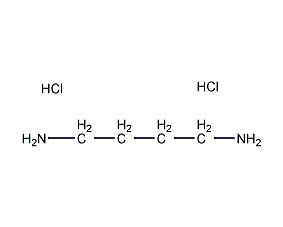1,4-diaminobutane dihydrochloride


Structural formula
| Business number | 049P |
|---|---|
| Molecular formula | C4H14Cl2N2 |
| Molecular weight | 161.07 |
| label |
1,4-diaminobutane, 1,4-Butanediamine dihydrochloride, 1,4-Butanediamine bishydrochloride, 1,4-diaminobutane dihydrochloride, 1,4-Butanediamine hydrochloride, 1,4-Diaminobutane dihydrochloride, 1,4-Diaminobutane hydrochloride, 1,4-diaminobutane dihydrochloride, DIAMINOBUTANE DIHYDROCHLORIDE, 1,4-BUTANEDIAMINE DIHYDROCHLORIDE, 1,4-BUTANEDIAMMONIUM DICHLORIDE, 1,4-DIAMINOBUTANE 2HCL, 1,4-DIAMINOBUTANE DIHYDROCHLORIDE, 1,4-DIAMINOBUTANE HYDROCHLORIDE, PUTRESCINE DIHYDROCHLORIDE, PUTRESCINE HYDROCHLORIDE |
Numbering system
CAS number:333-93-7
MDL number:MFCD00012526
EINECS number:206-375-9
RTECS number:EJ7280000
BRN number:3906680
PubChem ID:None
Physical property data
一 , physical property data
Traits :White crystalline powder with a strong ammonia odor.
Density (g/mL,25/4℃): 0.8777
Relative Vapor density (g/mL, air=1):Not available
Melting point (ºC): 280
Boiling point (ºC, normal pressure): 158-159
Boiling point (ºC, 5.2kPa): Not available
Refraction Rate: 1.4567
Flash Point (ºC): 51
Optical rotation (º): Not available
Spontaneous combustion Point or ignition temperature (ºC): Not available
Steam Pressure (kPa, 25ºC): Not available
saturated Vapor pressure (kPa, 60ºC): Not available
Burn Heat (KJ/mol):Not available
Critical Temperature (ºC): Not available
Critical Pressure (KPa): Not available
oil and water Log value of the (octanol/water) partition coefficient:Not available
Explosion Upper limit (%, V/V): Not available
Explosion Lower limit (%,V/V): Not available
Dissolve Properties:Easily soluble in water, able to absorb carbon dioxide
Toxicological data
Two , Toxicological data:
Acute Toxicity:Not available .
Ecological data
Three , Ecological data:
1 ,Other harmful effects: This substance may be harmful to the environment, and special treatment should be given to water bodies. Notice.
Molecular structure data
1. Molar refractive index: 27.65
2. Molar Volume (m3/mol):101.9
3. isotonic specific volume (90.2K):249.3
4. Surface tension ( dyne/cm):35.8
5. Polarizability(10-24cm3):10.96
Compute chemical data
1. Reference value for hydrophobic parameter calculation (XlogP): None
2. Number of hydrogen bond donors: 4
3. Number of hydrogen bond acceptors: 2
4. Number of rotatable chemical bonds: 3
5. Number of tautomers: none
6. Topological molecule polar surface area 52
7. Number of heavy atoms: 8
8. Surface charge: 0
9. Complexity: 17.5
10. Number of isotope atoms: 0
11. Determine the number of atomic stereocenters: 0
12. Uncertain number of atomic stereocenters: 0
13. Determine the number of chemical bond stereocenters: 0
14. Number of uncertain chemical bond stereocenters: 0
15. Number of covalent bond units: 3
Properties and stability
None yet
Storage method
None yet
Synthesis method
Succinioxime is obtained by reacting pyrrole and hydroxylamine hydrochloride, and then reduced to obtain butanediamine.
Purpose
Combined toDNAReceptor polyamine regulatory point, strengtheningNMDAInduced current.